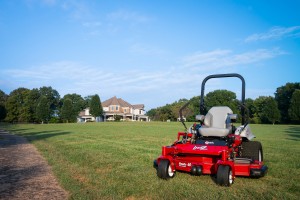Spring is here… Is your lawn ready? Whether you’re a landscaping business or a homeowner, it takes dedication to give your lawn that lush, green, and inviting feel you’re after. When it comes to watering, there are good ways to water a lawn, and then there are better ways. If you want the best way, you’ll need to know how to water your lawn sufficiently while avoiding the problems — and higher costs — of over watering.
Take a Look at the Climate
After a long winter, a green lawn sounds really good this time of year. When preparing to water, there are a few things to bear in mind — one is the climate. If you are experiencing enough rainy weather to sustain your grass, there’s no need to turn on a sprinkler. This only wastes water and sends your money down the drain. Also, be aware of any drought conditions in your area and whether outdoor water use is restricted in some way.
You shouldn’t begin a regular watering schedule until the days grow warmer, the grass is exposed to more sunlight, and the number of rainstorms diminishes. A moisture sensor, when added to your existing system, can eliminate guesswork about when to begin watering. The sensor automatically prevents irrigation when moisture in the lawn is sufficient, so you only water when the lawn needs it.
A Note on Aeration
It’s also a great idea to aerate and fertilize the grass at the beginning of the watering season. Aeration will allow the lawn to absorb moisture, air, and fertilizer more effectively. Your lawn will turn green faster and will require less water to do so.
How Often to Water
Proper watering should not require you to water a lawn every day. Your grass often benefits more if you water deeply 2-3 times each week. Here are a few tips:
- Program your timer to turn on the sprinklers during the time of day when evaporation is low. Early morning is the best time to water.
- Avoid watering between 10 am and 6 pm. The afternoon heat will cause water to evaporate more quickly.
- Avoid watering in the middle of the night unless you live in a very dry climate. Mid-night watering can cause excess moisture, which can result in mold or fungus growth.
How Much Is Enough?
During the summer months, your grass should receive between 1- to 1.5-inches of water each week. Watering three times per week means you should apply about 1/2-inch of water each day you water. But take note — if you see water running off your lawn and into the street, make sure to read “What is the Proper Technique” below.
How Long Should You Water?
There is a difference between determining how much you should water and how long you should water. The key link between the two is the type of sprinklers in your system and how fast they apply water.
For conventional spray-type sprinklers, you can apply 1/2-inch of water in about 30 minutes. For rotary-type sprinklers, usually used for larger turf areas, applying 1/2-inch of water takes about 60 minutes. You can determine your application rate in a couple of different ways:
- Before turning on the sprinklers, place empty tuna cans around your yard, particularly in areas you want to make sure are getting enough water. After watering for 10 minutes, use a ruler to measure and record the depth of water in each can. Using the average depth, you can now determine how long it takes to apply 1/2-inch of water to your lawn.
- Use a rain gauge to measure.
Deep watering like this will encourage deeper root growth. With deeper roots, the grass will be able to continuously draw on more water hidden beneath the surface.
What Is the Proper Technique?
There is a proper technique to watering if you want to make sure your lawn is receiving even coverage. Otherwise, some areas could become saturated while others aren’t receiving enough.
At the beginning of the season, test your sprinklers to ensure that they cover the entire lawn without spraying over onto driveways and walkways, or creating runoff. You can also test for even coverage with the tuna can trick mentioned in the above section. Sprinkler patterns should overlap 100% if possible. This is called “head-to-head” spacing and helps improve how evenly the water is distributed on the grass.
If you’re watering deeply, the soil will help spread the water more evenly and it won’t be quite as critical for your sprinklers to cover every inch. However, the more head-to-head coverage you have, the more efficient your sprinkler system will be. And the higher the efficiency of the sprinkler system, the less water is required to keep your grass green and healthy.
If there is runoff onto the street, try splitting your total run time into two or three segments. For example, if your system needs 30 minutes to deliver 1/2-inch of water to your lawn on a given day, set your run time to 10 minutes and program two repeat segments. Allow the lawn enough time (about 15-30 minutes) to absorb the water from the first watering session before allowing the system to water again. Repeat the watering segments until you have watered deeply.
Tips for Mowing
Be sure to only mow your lawn when the grass is dry, and avoid mowing in the heat of the day, as this can cause excess stress to the grass. Also, do not mow too short or the grass will become unhealthy, less able to grow, and more vulnerable to diseases and weeds. Only mow about one-third off the length of the grass blades at most.
Why to Conserve Water
Conserving water is not just important if you live in a desert climate or a drought-prone area. Water conservation will save you money on your water bill and will ultimately do favors for a green, vibrant lawn. Overwatering your lawn isn’t just unneeded; it can be bad news for the lawn and the environment. It can lead to fungus and mold growth, and can cause sinkholes and other problems in the yard.
You can actually build a more resilient lawn by allowing it to go without water for a day or two (or three). This will encourage the grass to sink deeper roots into the soil to find more water. Just remember to water the lawn deeply when you do water to support this root growth.
Ready for a beautiful lawn? It may not take as much work, or water, as you think.








